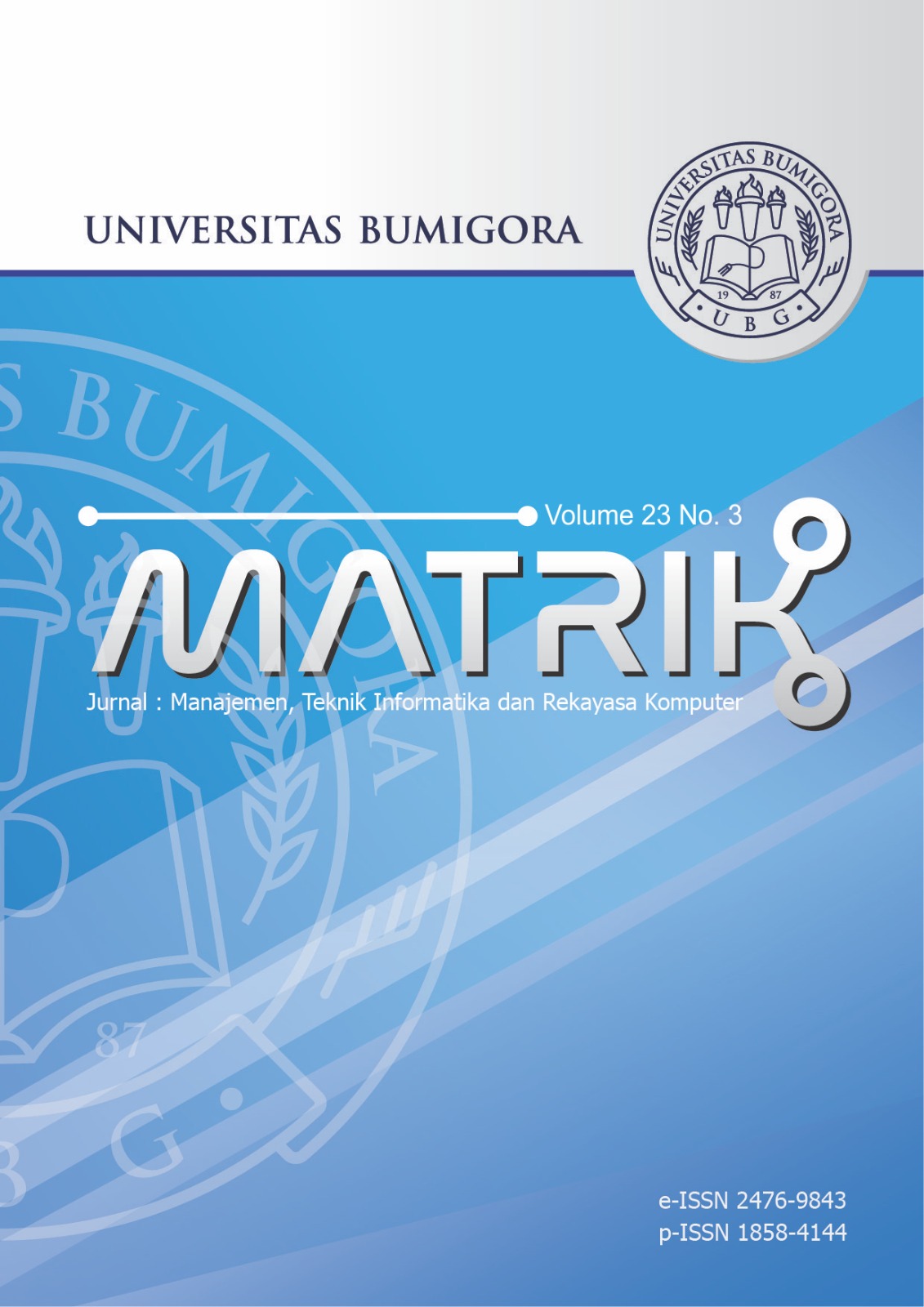Classification of Cash Direct Recipients Using the Naive Bayes with Smoothing
Abstract
Direct Cash Assistance is a social program distributed to residents meeting specific requirements. The village government determines the recipients using a conventional system through village meetings. This approach is greatly influenced by the decision-holders’ subjectivity with non-transparent thinking. This research aims to solve the problem of classifying Direct Cash Assistance recipients by applying probability-based classification. The research method used is smoothed Nave Bayes, which improves Nave Bayes by adding a constant to avoid zero classification. The datasets use variables such as age, type of work, and criteria for receiving assistance. The last variable includes five nominal data, which debilitates Nave Bayes by not obtaining a posterior probability as a prediction class result. We used Direct Cash Assistance data from the Sedati sub-district, Sidoarjo district, East Java. The results of research with original Nave Bayes and smoothed Nave Bayes classification show that smoothed Nave Bayes has good prediction performance with an accuracy of 95.9% with a data split of 60:40. Smoothed- Nave Bayes also solves the problem of 8 data without predictive classes. The prediction results show that Smoothed Nave Bayes performs better than standard Nave Bayes. This research contributes to refining Nave Bayes to complement probability-based classification by adding refinement constants to avoid zero classification.
Downloads
References
assistance in refugee crises,” International Journal of Disaster Risk Reduction, vol. 96, no. 1, pp. 1–27, Oct. 2023,
https://doi.org/10.1016/j.ijdrr.2023.103907.
[2] A. Maghsoudi, R. Harpring, W. D. Piotrowicz, and D. Kedziora, “Digital technologies for cash and voucher assistance in
disasters: A cross-case analysis of benefits and risks,” International Journal of Disaster Risk Reduction, vol. 96, no. 1, pp.
1–16, Oct. 2023, https://doi.org/10.1016/j.ijdrr.2023.103827.
[3] E. Juntunen, C. Kalla, A. Widera, and B. Hellingrath, “Digitalization potentials and limitations of cash-based
assistance,” International Journal of Disaster Risk Reduction, vol. 97, no. 1, pp. 1–12, Oct. 2023, https:
//doi.org/10.1016/j.ijdrr.2023.104005.
[4] A. Agrawal, N. Kaur, C. Shakya, and A. Norton, “Social assistance programs and climate resilience: reducing vulnerability
through cash transfers,” Current Opinion in Environmental Sustainability, vol. 44, no. 1, pp. 113–123, Jun. 2020,
https://doi.org/10.1016/j.cosust.2020.09.013.
[5] N. Alfiah, “Klasifikasi Penerima Bantuan Sosial Program Keluarga Harapan Menggunakan Metode Naive Bayes,” Respati,
vol. 16, no. 1, pp. 32–40, Mar. 2021, https://doi.org/10.35842/jtir.v16i1.386.
[6] A. Andika, S. Syarli, and C. R. Sari, “Data Mining Klasifikasi Kelulusan Mahasiswa Menggunakan Metode Nave Bayes,”
Journal Peqguruang: Conference Series, vol. 4, no. 1, pp. 423–428, May 2022, https://doi.org/10.35329/jp.v4i1.2358.
[7] N. K. A. Suarpurningsih, N.W. Utami, and N. M. Estiyanti, “Klasifikasi Penentuan Kelayakan Pemberian Kredit Menggunakan
Metode Naive Bayes Classifier (Kasus: Koperasi Simpan Pinjam Artha Segara),” J-SAKTI (Jurnal Sains Komputer dan
Informatika), vol. 6, no. 1, pp. 391–404, Mar. 2022, https://doi.org/10.30645/j-sakti.v6i1.454.
[8] A. Junaidi, Y. Yunita, S. Agustyani, C. I. Agustyaningrum, and Y. T. Arifin, “Klasifikasi Penerima Bantuan Sosial Menggunakan
Algoritma C 4.5,” Jurnal Teknik Komputer, vol. 9, no. 1, pp. 77–82, Jan. 2023, https://doi.org/10.31294/jtk.v9i1.14378.
[9] E. Fitriani, “Perbandingan Algoritma C4.5 dan Nave Bayes untuk Menentukan Kelayakan Penerima Bantuan Program Keluarga
Harapan,” Sistemasi: Jurnal Sistem Informasi, vol. 9, no. 1, pp. 103–115, Jan. 2020, https://doi.org/10.32520/stmsi.v9i1.596.
[10] A. Damuri, U. Riyanto, H. Rusdianto, and M. Aminudin, “Implementasi Data Mining dengan Algoritma Nave Bayes Untuk
Klasifikasi Kelayakan Penerima Bantuan Sembako,” JURIKOM (Jurnal Riset Komputer), vol. 8, no. 6, pp. 219–225, Dec.
2021, https://doi.org/10.30865/jurikom.v8i6.3655.
[11] D. N. Aini, B. Oktavianti, M. J. Husain, D. A. Sabillah, S. T. Rizaldi, and M. Mustakim, “Seleksi Fitur untuk Prediksi Hasil
Produksi Agrikultur pada Algoritma K-Nearest Neighbor (KNN),” Jurnal Sistem Komputer dan Informatika (JSON), vol. 4,
no. 1, pp. 140–145, Sep. 2022, https://doi.org/10.30865/json.v4i1.4813.
[12] A. A. A. Arifin,W. Handoko, and Z. Efendi, “Implementasi Metode Naive Bayes Untuk Klasifikasi Penerima Program Keluarga
Harapan,” J-Com (Journal of Computer), vol. 2, no. 1, pp. 21–26, Mar. 2022, https://doi.org/10.33330/j-com.v2i1.1577.
[13] N. K. W. Patrianingsih and I. K. A. Sugianta, “Penerapan Nave Bayes pada Potensi Akademik Siswa SD
Negeri 5 Singakerta,” JISKA (Jurnal Informatika Sunan Kalijaga), vol. 8, no. 2, pp. 154–163, May 2023,
https://doi.org/10.14421/jiska.2023.8.2.154-163.
[14] L. Budhy Adzy, A. Asriyanik, and A. Pambudi, “Algoritma Nave Bayes untuk Klasifikasi Kelayakan Penerima Bantuan
Iuran Jaminan Kesehatan Pemerintah Daerah Kabupaten Sukabumi,” Jurnal Mnemonic, vol. 6, no. 1, pp. 1–10, May 2023,
https://doi.org/10.36040/mnemonic.v6i1.5714.
[15] D. Azlil Huriah and N. Dienwati Nuris, “Klasifikasi Penerima Bantuan Sosial UMKM Menggunakan Algoritma Nave Bayes,”
JATI (Jurnal Mahasiswa Teknik Informatika), vol. 7, no. 1, pp. 360–365, Mar. 2023, https://doi.org/10.36040/jati.v7i1.6300.
[16] A. W. S. Sriwibowo, A. Alwi, and S. Sugianti, “Application of the Nave Bayes Algorithm in Predicting Acceptance of Family
Hope Program Assistance (PKH):,” JICTE (Journal of Information and Computer Technology Education), vol. 4, no. 1, pp.
1–8, Sep. 2020, https://doi.org/10.21070/jicte.v4i1.916.
[17] F. Santoso, Sunardi, and H. Z. Lukman, “Implementasi Data Mining dengan Metode Naive Bayes Untuk Memprediksi
Penerimaan Siswa Baru di MTS NU Islamiyah Asembagus,” G-Tech: Jurnal Teknologi Terapan, vol. 7, no. 4, pp. 1355–1366,
Oct. 2023, https://doi.org/10.33379/gtech.v7i4.3086.
[18] N. Nurdin, E. Susanti, H. A.-K. Aidilof, and D. Priyanto, “Comparison of Naive Bayes and Dempster Shafer Methods in
Expert System for Early Diagnosis of COVID-19,” MATRIK : Jurnal Manajemen, Teknik Informatika dan Rekayasa Komputer,
vol. 22, no. 1, pp. 215–228, Nov. 2022, https://doi.org/10.30812/matrik.v22i1.2280.
[19] N. G. A. Dasriani, S. Hadi, and M. Syahrir, “Intelligent System for Internet of Things-Based Building Fire Safety with Naive
Bayes Algorithm,” MATRIK : Jurnal Manajemen, Teknik Informatika dan Rekayasa Komputer, vol. 23, no. 1, pp. 229–242,
Nov. 2023, https://doi.org/10.30812/matrik.v23i1.3581.
[20] H. N. F. Fikrillah, S. Hudawiguna, and C. Juliane, “Klasifikasi Penerima Bansos Menggunakan Algoritma Naive
Bayes,” JATISI (Jurnal Teknik Informatika dan Sistem Informasi), vol. 10, no. 1, pp. 683–695, Mar. 2023,
https://doi.org/10.35957/jatisi.v10i1.3624.
[21] D. Kurniadi, F. Nuraeni, and M. Firmansyah, “Klasifikasi Masyarakat Penerima Bantuan Langsung Tunai Dana Desa
Menggunakan Nave Bayes dan SMOTE,” Jurnal Teknologi Informasi dan Ilmu Komputer, vol. 10, no. 2, pp. 309–320, Apr.
2023, https://doi.org/10.25126/jtiik.20231026453.
[22] Dedy Sugiarto, Ema Utami, and Ainul Yaqin, “Perbandingan Kinerja Model TF-IDF dan BOW untuk Klasifikasi Opini
Publik Tentang Kebijakan BLT Minyak Goreng,” JURNAL TEKNIK INDUSTRI, vol. 12, no. 3, pp. 272–277, Dec. 2022,
https://doi.org/10.25105/jti.v12i3.15669.
[23] S. Supangat, M. Z. B. Saringat, and M. Y. F. Rochman, “Predicting Handling Covid-19 Opinion using Naive Bayes and
TF-IDF for Polarity Detection,” MATRIK : Jurnal Manajemen, Teknik Informatika dan Rekayasa Komputer, vol. 22, no. 2, pp.
173–184, Mar. 2023, https://doi.org/10.30812/matrik.v22i2.2227.

This work is licensed under a Creative Commons Attribution-ShareAlike 4.0 International License.


.png)













